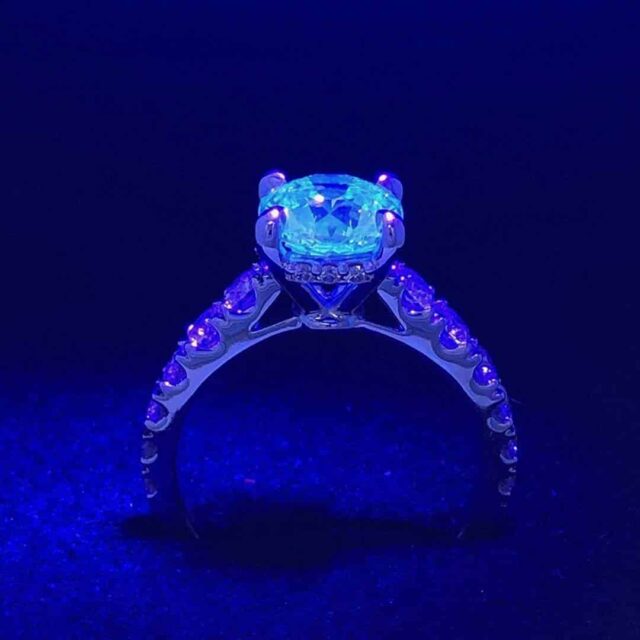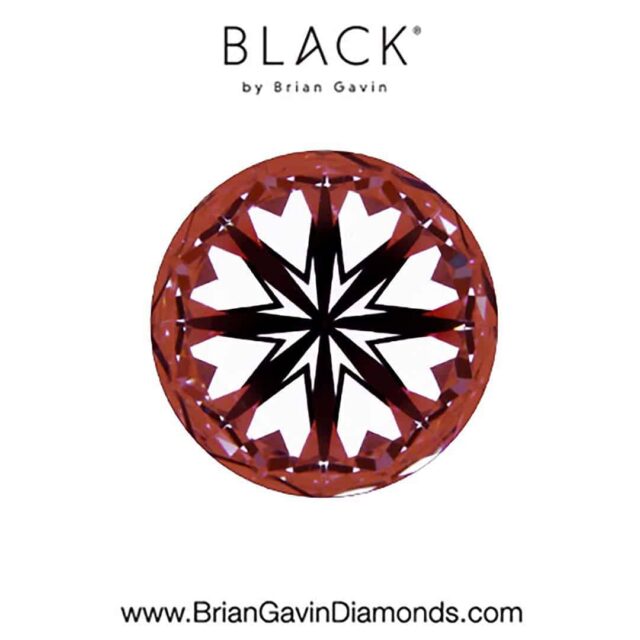This Round Brilliant Cut Diamond buying guide provides everything you need to know to buy a phenomenal-looking diamond online. And it only takes about a minute to read. So, Get Ready. Set. Go!
The Best Proportions for Round Diamonds
This extremely narrow range represents the target range or 'sweet spot' widely known to produce the best-looking round brilliant cut diamonds. Some prefer and recommend other combinations, but adhering to this spectrum dramatically increases your odds of finding an exceptional-looking diamond.
Why Proportions Matter
A diamond's proportions influence its light performance, including the balance of brilliance, dispersion, and scintillation. Proper proportions ensure that light entering a diamond reflects back toward the observer.
The proportions above are the center "Target Zone" of the AGS Ideal and GIA Excellent grades. It is considerably narrower than the GIA Excellent Cut rating relies upon, and formerly the AGSL Ideal-cut rating.
As such, it sets the light performance stage and produces a virtual balance of sparkle factor:
Round brilliant cut diamonds with our preferred proportions and higher degrees of optical precision exhibit more contrast brilliance and fewer negative traits like:
Illuminating Performance Factors
Overall Cut Grade
The diamond should have an overall cut grade of GIA Excellent, an AGS Ideal rating, and proportions within the specified range below.
Note: At the end of 2022, the GIA acquired AGS's Angular Spectrum Evaluation Tool (ASET). The AGS Ideal Report, including the ASET map, is optional when submitting diamonds to the GIA Gem Trade Laboratory.
In our experience, most online vendors forego the optional AGS Ideal Report because the ASET reveals inconsistencies in light performance. However, GIA reports for high-performance brands, such as Brian Gavin and Whiteflash, provide the supplementary insight ASET offers.
Optical Precision
This is the consistency of facet shape, size, and alignment from a 360-degree perspective. The GIA and other gemological labs do not account for optical precision.
We judge light performance using ASET and optical precision using Hearts & Arrows Scope images, such as those provided by Brian Gavin and Whiteflash. Alternatively, James Allen provides Ideal Scope images for their True Hearts Diamonds to judge light leakage.
A Quick Primer on Diamond Color
Pro Tip: Think of diamond color in terms of temperature. Some prefer the crisp, icy appearance of colorless diamonds, while others prefer the warm, richer appearance of near-colorless and faint-yellow diamonds.
The Allure of Blue Fluorescence
Blue fluorescence can make diamonds seem whiter and brighter in specific lighting environments. We favor Brian Gavin Blue fluorescent diamonds with medium to strong blue fluorescence.
Pro Tip: Avoid white or yellow fluorescence in gem-quality white diamonds because it can negatively influence our perception of diamond color.
A Quick Peek Into Diamond Clarity
Pro Tip: The industry will label the diamond eye-clean if the inclusions are not readily and immediately visible to a trained diamond grader from that distance.
However, this differs from how people scrutinize their diamonds upon receipt. Under those circumstances, only consider SI-clarity diamonds if you can accept the possibility of seeing inclusions without magnification.
It's also essential to realize that the SI-clarity grade encompasses the broadest possibilities. In that case, you might find a spectacular SI1 clarity specimen sitting on the fence towards VS2 clarity and another borderline SI2 clarity.
Beyond Making the Cut
The overall cut grade on a diamond grading report is not all-inclusive. In fact, it merely provides a glimpse into the characteristics essential to light performance.
Remember that the labs don't account for optical precision, a critical performance factor. Under those circumstances, the Excellent/Ideal-cut ratings should be the minimum search criteria. Then, when available, we'll use the ASET and H&A Scope images to determine the best-performing options.
Diamond Grading Reports
It's important to understand that gemological laboratories use different grading standards. While many regard the GIA Gem Trade Laboratory as the industry benchmark, GCAL, HRD, and IGI are also reputable and reliable.
Pro Tip: Global diamond prices are based on the Basic 4Cs and little-known factors of diamond cut quality. Diamonds graded by labs other than the GIA often come at a lower price but reflect industry perceptions that grading standards may vary. In that case, it's essential to compare prices based on characteristics determined by the same laboratory.
What Are Super Ideal Cut Diamonds?
Most people have yet to discover the performance differences between GIA Excellent, Ideal-cut, and Hearts and Arrows Super Ideal-cut diamonds.
Super ideal cut diamonds are polished to specific proportions with ultra-precise optical precision, creating superior performance. Optical precision is the consistency of facet shape, size, and alignment from a 360-degree perspective.
The GIA Excellent cut grade primarily depends on polish, symmetry, and proportions, with some consideration given to the consistency of facet shape. However, there is enough room for inconsistencies to create significant amounts of light leakage.
Turbo Charging Sparkle Factor
The cut quality of a super-ideal cut diamond goes above and beyond the standard overall cut grade criteria. It takes 4X longer to polish a super-ideal cut diamond to exhibit the crisp and complete Hearts and Arrows pattern, which signifies near-perfect optical precision.
Now, you might be thinking: Who cares about a hearts-and-arrows pattern that cannot be seen without a scope? The pattern consistency, or lack thereof, enables us to predict the degree of optical performance.
In other words, we can determine a diamond's performance based on its proportions and degree of optical precision, as evidenced by the ASET and Hearts & Arrows Scope images.
Beauty is in the Eye of the Beholder
They like to say there's an ideal cut diamond for every preference. Some people prefer brilliance or dispersion, so the labs incorporate a broad range of proportions in their grading standards.
We prefer a virtual balance of brilliance and dispersion in the form of broad-spectrum sparkle. The sweet spot lies dead center between the averages.
So, we recommend a tighter range of proportions and higher optical precision, as evident in the Hearts and Arrows Super Ideal-cut diamonds by Brian Gavin and Whiteflash.
Are Super Ideal Cut Diamonds Worth It?
Super ideal-cut diamonds are polished to the highest precision within specific proportions, producing a bolder, more vivid, and more intense sparkle. The degree of optical precision exceeds the GIA Excellent and AGS Ideal-cut grading criteria.
Diamonds are available in a broad range of cut qualities and resulting performance. Only some people want or need the very best. While H&A Super Ideal Cut diamonds provide better light performance, they also cost more due to production requirements.
Our aim is not to tell you what to buy but to guide you through the discovery process of determining your preferences and understanding the effects of proportions and optical precision.
Therefore, when you submit diamonds for review via our Concierge Service, we'll explain the pros and cons, enabling you to make an informed decision.




